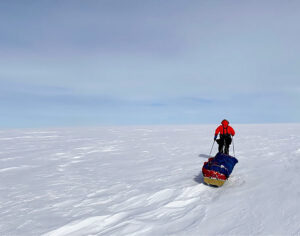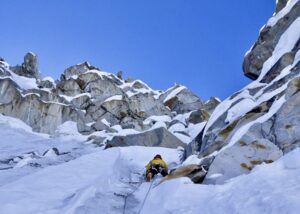Mike Horn (the end, or not), Lisa Blair (massive waves), and the kayakers, Cristian Donoso, Roger Rovira and Exequiel Lira (zero visibility)
Updated Februay 8, 2017: “After 57 days, on the 7th of February at 22:50 UT Mike Horn reaches the end of the Antarctic Continent! It’s Done!!” reads the message Mike Horn sent to his home team.
Mike is staying longer on the ice than he expected, due to unfavorable kiting conditions, and now his boat has problems. Lisa’s boat got hit by a two-story wave, and the three kayakers visit more island, sometimes in zero visibility.
Mike Horn and Pangaea
His crew and Pangaea are supposed to pick Mike up when he arrives on the other side of Antarctica, but now they had to return to Tasmania due to a big electrical problem, Mike reported 13 hours ago. “Later I will know more as to if and when they will be able to arrive.”
For a skier, Mike is late in the season on Antarctica. Logistic company ALE has already closed operations, and ALCI usually has their last Ilyushin-76 flight from Novolazarevskaya (near from where Mike stepped on the ice) at the end of February. Mike relies on his boat to pick him up, not a plane. The nearest airfield from where Mike is, is probably the US Science Station, McMurdo.
On February 1, he was still in the same position as the previous days and said it feels like he lives there. “The scenery has not changed much it stayed whiteout for most of the day it was only the snowdrifts and Sastrugi that built up around my tent and sled.” He shoveled heaps of snow and fixed his kite that was ripped in half, by sewing about 4.5 meter by hand. “The good thing about having tired eyes and fingers after fixing the kite is that it gave my feet, ankle, and tibia a rest.” Later the day he traveled 22 km and to S70º 15′ E137º 31’.
February 2 he wrote, “We all make plans in life. In fact our whole life is based on a plan according to thing we can control and then more important on things we have no control of, destiny! My expeditions functions like life, so what I can control I try and prepare very well knowing it might change but always hoping it will go according to plan. Now for the past 4 days I have made little progress, it was definitely not in my plan but it is the way it is. Elements bigger than the human dictates that, although it’s very difficult to accept we have no choice. We have to adapt, he who can adapt will have an advantage.”
Adopt the pace of nature: her secret is patience, emphasized Mike. Now that his boat has turned back and he doesn’t make good progress, “2 things not going according to plan, it could be the end of the world or not. It is what it is. Looking at the glass of water it is not half empty or half full it is what it is. …and sometimes it’s the end of the world for most, if we have to wait 1 minute longer for our coffee to be served…!”
Mike Horn (ZA/CH) started at S70.1015 W009.8249, on December 13, 2016. After 28 days he reached the Geographic South Pole, 90ºS, and turned his compass North.
Rerun – AdventureStats Special: What is Solo?
Interactive Map: Antarctica Skiing Routes
2016-17 Antarctica Ski Expedition List
Lisa Blair and Climate Action Now
The Australian solo sailor started her 360-degree Antarctica circumnavigation on January 22. On February 2 she wrote in detail how her boat was slammed by big waves and eventually by a two-story wave.
About halfway through her lunch a massive wave cracked against the hull almost beam on with such force that the boat was instantly thrown sideways. “Stuff (my lunch included) flying everywhere. I braced myself in the galley sitting on my lovely little seat that Henry had made. The wave had hit in such a way that the boat went from 10 knots to almost a complete stand-still.” Fortunately, nothing broke.
Shortly after, she was upended once again by another wave “only this one didn’t slow me down, it sped me up. As the boat laid over I could feel the boom starting to dig into the water – BANG. A loud snap and I knew right away that I had broken the preventer line again. This means that I need to go right out on the bow of the boat to retrieve it.” She covered up and went out, fell and hurt her knee.
After fixing the preventer line, Lisa went out again. “I was looking out towards the back of the boat watching the swell. I was trying to figure out where those extra kicks had come from. I couldn’t see much in the way of a large wave until after about five minutes this monster reared up behind me. It was at least 3 times the size of the rest of the swell. When I was in the trough looking up, the peak would have been at least the height of a two-story house.”
Latest report says she is focusing on rest and recovering. She describes the importance of her power and charging capabilities. “I am trying to complete this record [attempt] 100% Eco Powered, as such I have a combination of 8 Solbian flexible solar panels supplied by Solar 4 RV’s, 2 ‘silentwind’ wind generators and 1 hydro generator.”
Lisa’s Antarctic Cup Racetrack route:
– The 360-degree Racetrack features gale force winds, high seas, fog, snow, icebergs, islands, extreme cold, the Antarctic circumpolar current, sailing above and below the southern Polar Convergence with the start and finish based out of Albany, Western Australia.
– The Racetrack features 3 electronic lanes and 18 electronic gates. Gates are named after famous Antarctic expedition leaders and famous yachtsman and yachtswomen.
– The Racetrack outer and inner boundaries are located on latitude 45° South and latitude 60° South making the Racetrack 900 nautical miles wide.
– The wide Racetrack allows competitors to take advantage of favorable weather systems rotating clockwise around Antarctica and within the boundaries of the Racetrack.
– The Southern Ocean officially starts below latitude 60° South (International Hydrographic Organisation (IHO). Latitude 60° South is also the border of the Antarctic Treaty Organisation.
– The southern ‘Polar Convergence’ is within the inner and outer boundaries of the Racetrack.
Follow her blog in the Pythom Dispatch Stream.
Cristian Donoso, Roger Rovira and Exequiel Lira
[Cristian’s short kayak reports Google Translated] January 31: They crossed to Livingston Island in low visibility and strong currents, and come to a site full of wild fauna.
February 1: With wind west, they navigate to Barrientos Island, and visit Ecuadorian basin on the way.
February 2: Navigating in zero visibility with the help of a compass. They reached Robert Island.
February 4: The team traveled between orcas, and more wildlife. “Beautiful.” Position 62° 20’ 26” South, 59° 35’ 40” West.
Relocate Halley VI Research Station
Video to watch. British Antarctic Survey (BAS) has successfully relocated Halley VI Research Station to its new home on the Brunt Ice Shelf. It took 13 weeks to move the world’s first fully relocatable research facility 23 km across the ice. The largest module (A module – living space) is seen her successfully making its way slowly to its new location on Brunt Ice Shelf.
Post South Pole 2016-17 Interviews on Explorersweb/Pythom:
Solo South Pole skier Sebastien Lapierre: “Mind over body” (Interview)
Interview: Johanna Davidsson, Record Solo Female skier and Return Journey on Antarctica
Previous/Related on Explorersweb/Pythom:
Kayaking the South Shetland Islands
Lisa Blair started Antarctica Circumnavigation
Risto completed Return; Malgorzata at the Pole
Johanna Davidsson set New Solo Female Speed Record
Editorial: Might is The Answer to Why (Updated)
Antarctica Current: Polar How-To-Guide Heads-Up
HumanEdgeTech Expedition Technology (e.g.CONTACT software)
AdventureStats.com for Polar Statistics and Rules. Note that a solo claim has to be unassisted,
therefore no supplies carried by pilots or car drivers, or anything (food, fuel, etc) received from any person along the way. A solo person may be wind supported (kites/sails). Claiming to have ‘skied to the Pole’, a full route (from a coastal start point) has to be completed, without flying part of the route.
Pre South Pole 2016-17 Interviews on Explorersweb/Pythom:
Exweb South Pole Interview with Johanna Davidsson: kite return attempt
Interview with Pata Degerman: Longest Snowmobile attempt on Antarctica
[UPDATE 2] Risto Hallikainen, solo South Pole return ski attempt (Interview)
1989: Arved Fuchs traversed Antarctica, with Messner (Interview)
Ryan Waters to guide Fuchs-Messner route (Antarctica 2016-17 interview)
Canadian Sébastien Lapierre to attempt solo ski to South Pole (Interview)
Cycle Antarctica: Hank van Weelden Pole to Coast attempt (Interview)
Emma Kelty: speed ski and return attempt (Exweb South Pole interview)
Eric Philips, South Pole 2016-17 New Start Point attempt (Interview)
Gateway port Cape Town, South Africa:
To ALCI base camp Novolazarevskaya / Novo
70° 46’37”S, 011° 49’26”E
Gateway port Punta Arenas, Chile, South America:
To ALE base camp, Union Glacier
79° 45’S, 083° 14’W elev 708m
Lat: -79.760591 Lon: -82.856698
Weather:
https://www.yr.no/place/Antarctica/Other/Union_Glacier/
ALE Union Glacier weather cam 79º 46’S, 83º 16”W
South Pole webcam 90ºS
#polar #antarctica #Southpole #thepoles #skisouthpole






